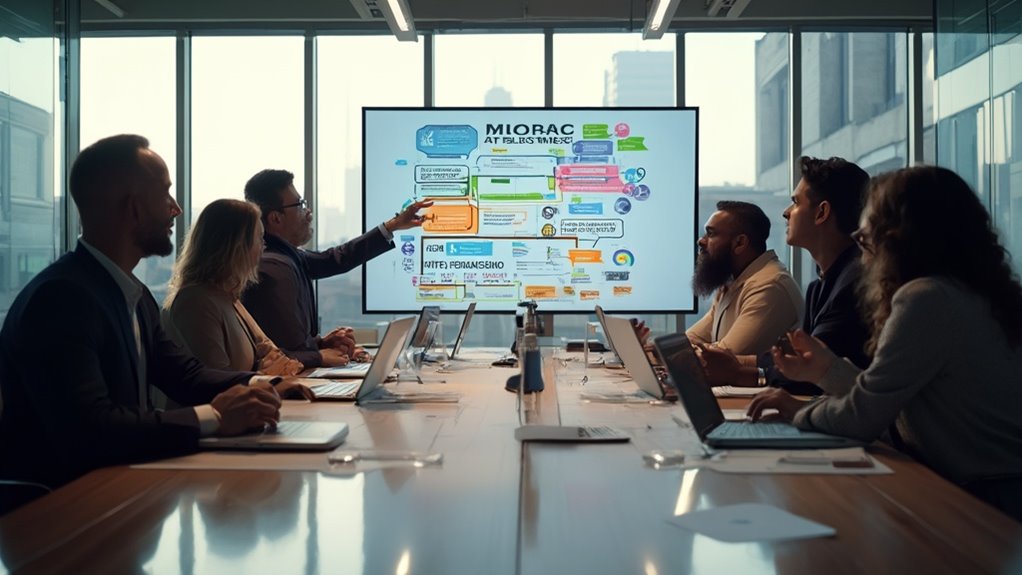To prepare your Smyrna business for disaster recovery with Care Pro, start with a thorough risk assessment. Identify potential risks and analyze their impact using tools like a risk matrix and decision tree. Assemble a cross-functional team to develop a solid business continuity plan, focusing on recovery priorities and clear objectives. Guarantee your IT systems have robust backup measures and defined recovery strategies. Regularly test your plans through simulations and training to spot weaknesses. Finally, establish clear communication channels and role definitions during crises. By following these steps, you'll set a strong foundation for resilience in uncertain times. Investigate further to improve your strategy.
Key Takeaways
- Conduct a thorough risk assessment to identify potential threats to your Smyrna business and prioritize them based on likelihood and impact.
- Assemble a cross-functional team to develop a comprehensive business continuity plan tailored to your company's specific needs and operations.
- Establish clear Recovery Point Objectives (RPO) and Recovery Time Objectives (RTO) to ensure effective recovery of critical business functions.
- Implement robust IT disaster recovery strategies, including regular data backups and defined communication protocols for activation during disruptions.
- Regularly test and update your disaster recovery plan through simulation exercises and checklist testing to ensure preparedness and identify weaknesses.
Risk Assessment and Analysis

A thorough risk assessment is crucial for preparing your Smyrna business for potential disasters. To effectively evaluate risks, you need to employ risk prioritization techniques that help identify which threats demand immediate attention. Start by utilizing qualitative assessment methods, which emphasize expert judgment in categorizing risks based on their likelihood and impact. This approach is particularly valuable when dealing with new or emerging risks that lack historical data. Additionally, prompt action can significantly reduce property damage, highlighting the importance of quick decision-making during crises.
Incorporating tools like the risk matrix allows you to visualize risks by plotting their likelihood against impact, facilitating a clearer understanding of your risk environment. Furthermore, decision tree analysis can guide you in evaluating various risk management strategies, ensuring informed choices based on potential outcomes. Implementing a systematic process for identifying and evaluating threats is essential for a comprehensive understanding of your risk landscape.
While quantitative risk assessments provide numerical data, they may not cover every risk scenario. Consequently, combining qualitative methods with vulnerability-based and threat-based assessments offers a more extensive evaluation. By focusing on both the potential vulnerabilities within your systems and the specific threats your organization faces, you can prioritize effectively. This proactive approach positions your business to mitigate risks and improve your overall disaster recovery strategy.
Business Continuity Strategy Development
After completing a thorough risk assessment, the next step in preparing your Smyrna business for unforeseen disruptions is developing a robust business continuity strategy. Start by assembling a cross-functional team with representatives from key departments like IT, operations, finance, and human resources. Clearly define each member's roles and responsibilities to guarantee effective leadership during emergencies. Resource allocation is vital here—make certain your team has the support and resources needed to plan and test for various scenarios.
Next, identify your recovery priorities, focusing on customer protection, regulatory implications, and brand concerns. Match these priorities with the necessary resources, including facilities, personnel, and technology. Establish recovery timelines by setting your Recovery Point Objective (RPO) and Recovery Time Objective (RTO). Document your all-encompassing plan in a concise manner, making sure it's easily accessible to relevant employees. Additionally, ensure your team is familiar with emergency water removal protocols to enhance readiness during crises.
Lastly, involve executive management to reinforce the importance of this strategy. Regularly update your business continuity plan to reflect any changes in your operations or external environment. This proactive approach will help minimize business impact and improve your resilience against disruptions.
IT Disaster Recovery Planning

When it comes to safeguarding your Smyrna business against potential IT disruptions, having a well-structured disaster recovery plan is vital. Start by conducting a thorough risk assessment and business impact analysis. Identify vulnerabilities in your IT infrastructure and assess how disruptions could impact essential processes. This analysis will help prioritize recovery efforts and allocate resources effectively.
Next, implement robust data backup and protection measures. Compile a detailed inventory of all IT assets, and establish a regular backup strategy using recovery technologies that minimize data loss. Consider integrating cloud solutions for secure and easily accessible backup storage.
Define clear recovery strategies and objectives, including Recovery Time Objectives (RTO) and Recovery Point Objectives (RPO) for each system. Develop practical approaches for data backup, system restoration, and communication under pressure.
Lastly, confirm everyone involved understands their roles and responsibilities during a crisis. Establish communication protocols that detail activation procedures and recovery steps. By meticulously planning these aspects of your IT disaster recovery, you'll improve your business's resilience and readiness to bounce back from any disruption.
Training and Testing Procedures
Regularly training your team and testing your disaster recovery plan are crucial steps in guaranteeing your Smyrna business can effectively respond to disruptions. Implementing a variety of training methods, like tabletop exercises and hands-on activities, helps prepare your personnel for real-world challenges. Tabletop exercises simulate disaster scenarios, allowing your team to assess plans without disrupting business processes. This promotes familiarity with your business continuity plan.
To guarantee thorough testing, consider the following procedures:
| Testing Type | Description |
|---|---|
| Simulation Testing | Mimics real-world disasters to identify weaknesses. |
| Checklist Testing | Verifies readiness of personnel and resources. |
| Parallel Testing | Runs recovery systems alongside production systems. |
| Full-interruption Testing | Tests the plan using actual production data. |
Communication and Role Definition

Effective training and testing of your disaster recovery plan set the stage for the next significant component: communication and role definition. Establishing clear communication channels—like emails, social media, and emergency notification systems—is critical for effective crisis messaging. You need to develop adaptable templates that guarantee your messaging remains clear, concise, and consistent across various scenarios.
Designating trained spokespersons is another important step. They'll address media inquiries, keeping all stakeholders informed and engaged during a crisis. Plan for post-disaster communication as well, focusing on recovery updates and the steps necessary to resume normal operations.
Internally, notify employees promptly about their roles and responsibilities. Clear instructions empower them to act decisively during a crisis. Coordinate communication across departments to unify efforts, and provide support for employees affected by the disaster.
Externally, guarantee transparent messaging to clients, partners, and vendors to maintain trust. Engage with the local community and comply with regulatory requirements in all communications. By clearly defining employee roles and establishing robust communication strategies, you'll improve your organization's resilience in the face of adversity.
Conclusion
By taking proactive steps in disaster recovery planning, you're not just safeguarding your Smyrna business; you're enhancing its resilience. Did you know that 60% of small businesses that experience a disaster close within six months? Don't let your business become part of that statistic. Implementing a thorough strategy that includes risk assessment, IT planning, and effective communication can make all the difference. Start preparing today to guarantee your business thrives, no matter what challenges arise.







